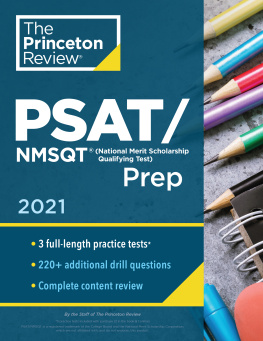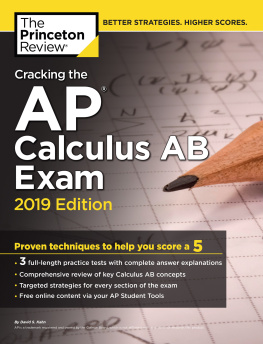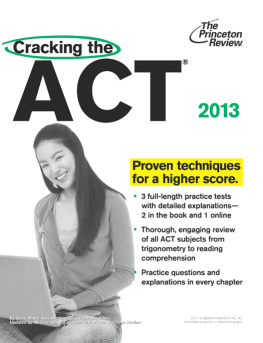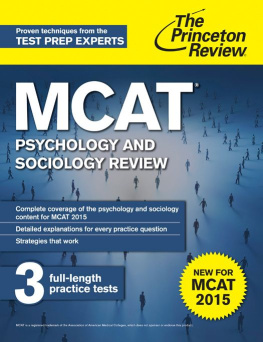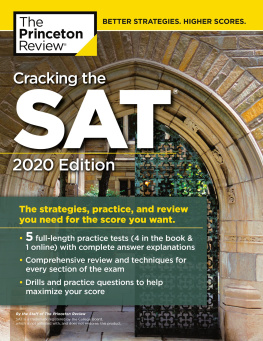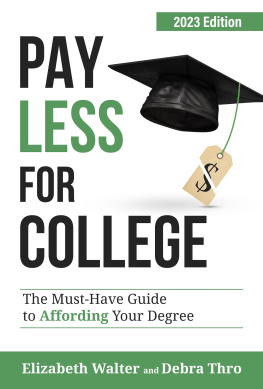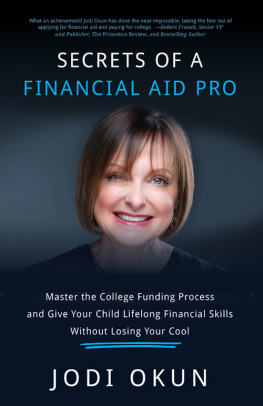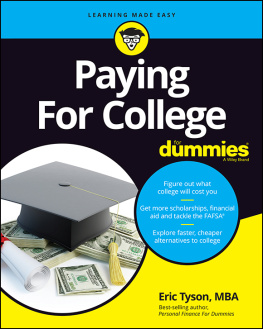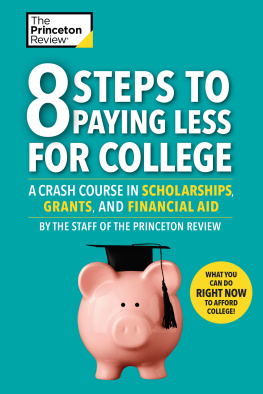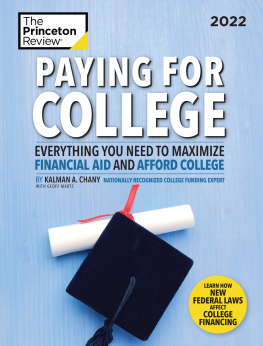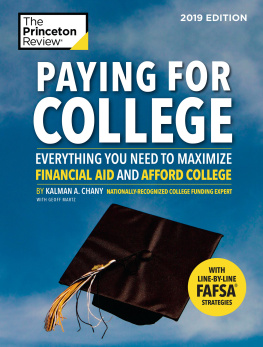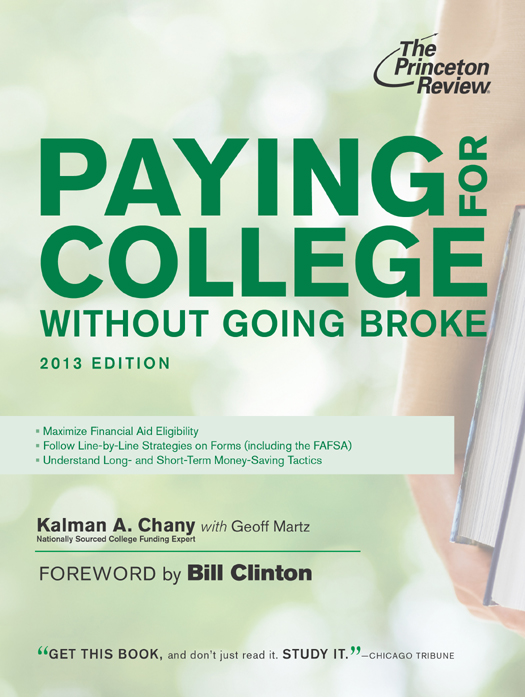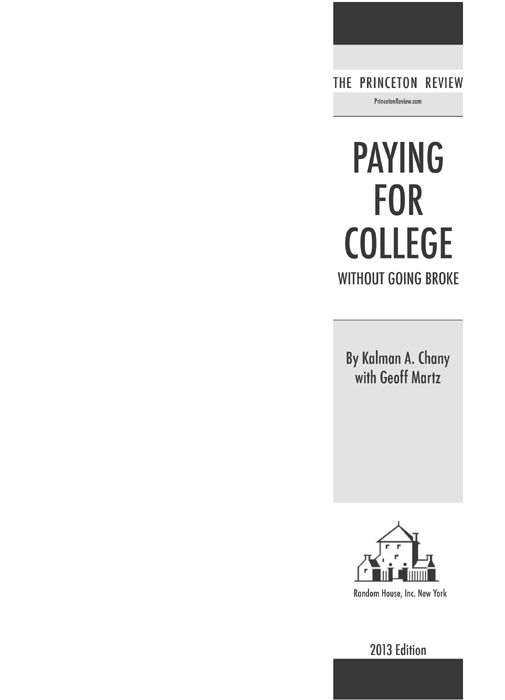The Princeton Review, Inc.
111 Speen St., Suite 550
Framingham, MA 01701
E-mail:
Copyright 1993, 1996, 1997, 1998, 1999, 2000, 2001, 2002, 2003, 2004, 2005, 2006, 2007, 2008, 2009, 2010, 2011, 2012 by The Princeton Review, Inc.
Cover art Corbis Super RF/Alamy
All rights reserved under International and Pan-American Copyright Conventions. Published in the United States by Random House, Inc., New York, and simultaneously in Canada by Random House of Canada Limited, Toronto.
This publication is designed to provide accurate information in regard to the subject matter covered as of the date of publication. Since tax laws, financial aid regulations, and government regulations change periodically, it is sold with the understanding that neither the publisher nor the authors are engaged in rendering legal, accounting, or other professional service. If legal advice or other expert assistance is required, the services of a competent professional person should be sought.
The draft version of the 20132014 FAFSA that appears on is for informational purposes only. It should not be submitted. The U.S. Department of Education did not review or provide any of the other information contained in this publication.
Source: The EFC figures provided for the case studies on are courtesy of the College Board. College Board, CSS/Financial Aid PROFILE, and the acorn logo are registered trademarks of the College Board. All rights reserved.
eISBN: 978-0-307-94533-4
ISSN: 1048-8514
Printed in the United States of America on partially recycled paper.
The Princeton Review is not affiliated with Princeton University.
2013 Edition
v3.1
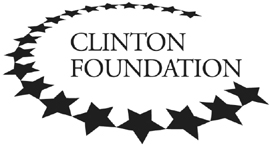
FOREWORD
I was the first person in my family to go to college. After completing my undergraduate studies, I went on to law school, and after thatbefore I entered political officeI was a law professor at the University of Arkansas. The time I spent in the classroom was vital to my professional growth, and I was able to pursue higher education only because I had the help of scholarships, loans, and jobs along the way. Though it wasnt always easyas an undergrad, I lived on just a few dollars a weekit was far from impossible, and the investments I made in both time and money have paid immeasurable returns. My schooling, as well as the friends I made and the life experience I gained throughout, gave me opportunities, confidence, and hope for my future.
A college education should never be considered unattainable by any American. There are many avenues for funding available, but knowing how to look for assistance, as well as where to find it, is critical. Fortunately, our country has long recognized the importance of access to higher education. The land grant college system was established under Abraham Lincoln, the GI Bill after World War II, and the Pell Grants in the 1970s. My Administration established the HOPE Scholarship and the Lifetime Learning tax credit, which together have provided billions of dollars in tax credits to tens of millions of American families paying for college. We created AmeriCorps, one of my proudest accomplishments as President, which gave young people the opportunity to serve their communities while earning money for college. We also expanded the Federal Work-Study program, cut student fees and interest rates on all loans, and increased repayment options. Students saved more than $9 billion during my terms in office through the reductions in loan fees and interest rates.
While it has long been a key source of opportunity, a higher education is a necessity in todays world. The challenges of todays lightning-paced and information-driven global society mean that investing in the minds of our young people is the most important thing our nation can do. Every American child, regardless of race, religion, or income, will need an education to guarantee our future success as a country and our competitiveness in the world, and I am committed to inspiring more young people to attend and finish college. Both my Foundation and the Clinton Global Initiative, along with many other fine public and private institutions, are working to not only spread the word that the cost of tuition shouldnt be an obstacle to attending college, but to also improve access to education in measurable ways. The good news is that there is more help than ever before for college-bound students and their families. Paying for College Without Going Broke is a comprehensive guide to the ins and outs of financing a college education. This straight-talking volume gives much-needed direction to students and the families who love and support them.
If you invest in your future through education, youre taking the long view. Both the efforts and the sacrifices you make today will yield great rewards tomorrow.
Bill Clinton
ACKNOWLEDGMENTS
Geoff Martz and I are most grateful to those who have helped with this and prior editions of the book. First of all, we wish to thank President Bill Clinton who has honored our book with his Foreword. Thanks also to Shannon Ashford and Felton Booker, Domestic Policy Interns with the William J. Clinton Presidential Foundation during the Summer 2003 Session, for preparing the Special Message to First-Generation College Students and Their Parents that appears in the beginning of the text.
We would also like to thank Robert Franek, Scott Harris, and other members of the production staff at The Princeton Review as well as to Tom Russell and Nicole Benhabib at Random House, and my publicist Jeanne Krier.
We are also grateful to Michele Brown, Anita Gross, Daria Adams, and Jeanne Saunders at the U.S. Department of Education as well as Susan McCrackin and Cindy Shelberg at the College Board who have been a tremendous source of help for many editions of this book.
I would also like to thank Isidore Matalon, my longtime friend and a constant source of new ideas; Steven Levine of the accounting firm of Lederer & Levine in Lyndhurst, New Jersey, for his helpful suggestions regarding tax law; Catherine OConnor, my associate at Campus Consultants without whom I could never have managed; my friends Stuart Foisy and John Brubaker for their assistance with the worksheets at the back of this book; the high school counselors and independent college consultants who have entrusted students and their parents to me over the years; and my own parents, who somehow managed to pay for my college education without the benefit of having read a book like this.
Last but not least, I would like to thank the clients who have provided the opportunity to prove that financial aid planning really works.
Kal Chany
CONTENTS
A SPECIAL MESSAGE TO FIRST-GENERATION COLLEGE STUDENTS AND THEIR PARENTS
by Shannon Ashford and Felton Booker
Paying for college is difficult for everyone these days, but for first-generation college students and their families, it can be even more of a challenge. In addition to worrying about coming up with the cash, you also have to deal with a completely unfamiliar process. You will face decisions, deadlines, and application requirements that can sometimes seem scarily complicated. This section is designed to provide first-generation students and their parents with some basic information regarding college admissions and college funding that will make the process a little less daunting for you both. It will also dispel some of the myths about the admission and funding process. Later sections in this book will discuss in greater detail the various options and strategies covered here.


